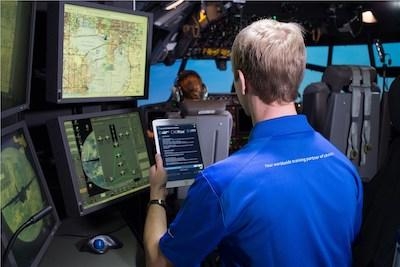Fri, Nov 30, 2018
Data-Driven Training System Provides Real-Time Insights And Standardized Evaluations (Rise) For Continuous Military Pilot Training Improvement
This week at at the Interservice/Industry Training, Simulation, and Education Conference (I/ITSEC), CAE announced the launch of CAE Rise for the defense market.

CAE Rise is a data-driven training system designed to enable defense and security organizations to deliver standardized training and give instructors a new approach to objectively assess pilot competencies using live data during training sessions. The system leverages big data analytics to reduce subjectivity in pilot assessment, allows instructors even greater focus on teaching, and helps create more efficient and continually improving training programs. CAE Rise is one of CAE’s latest digital innovations and has already been deployed for training CAE’s airline partners.
CAE conducted demonstrations each day during the show, with CAE Rise integrated on a T-6C simulator. The demonstrations show how CAE Rise gathers data during simulator training sessions, and then provides an instructor with real-time, objective assessments of student performance against pre-determined criteria for specific training tasks.
“CAE Rise is a prime example of CAE’s commitment to investing in the development of digital technologies to revolutionize pilot training,” said Gene Colabatistto, CAE’s Group President, Defense & Security. “The aviation industry – both military and civil – faces the long-term challenge of producing sufficient numbers of highly-qualified pilots to meet demand. CAE’s focus on aviation training and innovations such as CAE Rise will contribute to making pilot training more efficient, standardized and objective, which ultimately helps produce higher-quality and better prepared pilots.”
Some of the key features, capabilities and benefits of CAE Rise for military pilot training include:
- Developed on Microsoft Azure Government for cloud computing to meet government cybersecurity and compliance requirements;
- Facilitating student-centric learning by providing digital lesson plans, real-time feedback and ability to tailor training to each student;
- Improving instructor performance by facilitating student interaction and reducing administrative burden;
- Enabling training organization efficiencies such as maintaining electronic records, identifying performance gaps, and implementing closed-loop, adaptive training.
(Image provided with CAE news release)
More News
Airplane Bounced About 3 Ft Then Touched Back Down And Then, With No Brakes Applied, The Airplane Began Veering To The Left Analysis: The pilot entered the airport traffic pattern >[...]
Aero Linx: British Microlight Aircraft Association (BMAA) The primary focus within all aviation activity is SAFETY. In all aspects of our sport SAFETY must come first, whether it b>[...]
From SnF25 (YouTube Edition): William Wynne Builds Practical Aircraft Engines on the Corvair Platform Seeking an affordable alternative to the traditional aircraft engine options, >[...]
How To Get A Story On Aero-TV News/Feature Programming How do I submit a story idea or lead to Aero-TV? If you would like to submit a story idea or lead, please contact Jim Campbel>[...]
From 2023 (YouTube Edition): Bridge of CiES CiES Inc. is a Bend, Oregon-based designer and manufacturer of modular embedded aircraft systems and sensors. The company’s fuel-l>[...]
 NTSB Final Report: Aviat A1
NTSB Final Report: Aviat A1 ANN's Daily Aero-Linx (07.08.25)
ANN's Daily Aero-Linx (07.08.25) Classic Aero-TV: Fly Corvairs Reliable Engine Alternative
Classic Aero-TV: Fly Corvairs Reliable Engine Alternative ANN FAQ: Contributing To Aero-TV
ANN FAQ: Contributing To Aero-TV Classic Aero-TV: CiES Fuel-Quantity and e-Throttle Systems Praised
Classic Aero-TV: CiES Fuel-Quantity and e-Throttle Systems Praised



